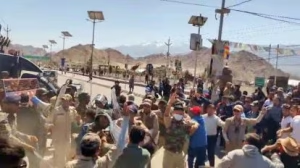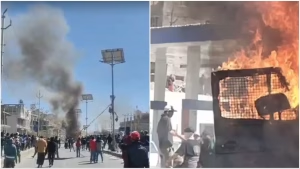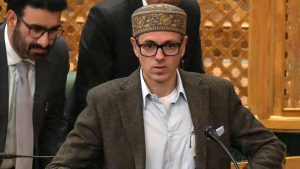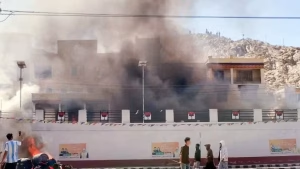Ladakh – The Ladakh statehood protest took a devastating turn on Wednesday as four people lost their lives and over 50 sustained injuries when police opened fire on demonstrators in Leh. What began as peaceful demands for statehood and Sixth Schedule protections escalated into unprecedented violence, marking a dark chapter in the region’s typically measured protest history.
The Ladakh statehood protest witnessed the torching of the BJP office in Leh as frustrated demonstrators broke away from the main peaceful gathering. This violent escalation prompted climate activist Sonam Wangchuk, who had been leading the movement through a 35-day hunger strike, to immediately call off his fast and appeal for restraint.
Background of the Statehood Movement

The current Ladakh statehood protest stems from long-standing grievances following the region’s conversion to Union Territory status in 2019. Protesters have been demanding full statehood along with inclusion under the Sixth Schedule of the Constitution, which would provide special protections for tribal communities and their land rights.
Wangchuk, addressing the media after the violence, expressed disappointment that the peaceful Ladakh statehood protest had been overshadowed by the actions of a breakaway group. He emphasized that thousands of protesters had been sitting peacefully, engaging in prayers and listening to speeches when a segment of youth marched out and began the rampage.
The Day of Violence Unfolds

Wednesday’s shutdown was called by student and youth organizations after two elderly protesters, aged 72 and 62, fainted during their hunger strike and required hospitalization. The Ladakh statehood protest had been gaining momentum as negotiations between the Centre and the Leh Apex Body were scheduled for October 6, marking the first talks in four months.
Also Read: Maharashtra Floods Relief: Massive Rs. 2,215 Crore Fund After 8 Deaths
According to police sources, 56 people were injured during the violence, with five in critical condition. Most injuries were caused by bullets and pellets as security forces attempted to disperse the increasingly aggressive crowd. The Leh administration responded by imposing restrictions on the assembly of four or more people as a precautionary measure.
Political Reactions and Broader Implications


The violent turn of the Ladakh statehood protest drew sharp reactions from regional political leaders. Jammu and Kashmir Chief Minister Omar Abdullah supported the protesters, stating that Ladakh felt “betrayed” by the Centre, drawing parallels to J&K’s unfulfilled statehood promises despite their democratic and peaceful approach.
Former J&K Chief Minister Mehbooba Mufti called for the Centre to move beyond “crisis management,” noting the disturbing shift from Leh’s traditionally peaceful protests to violent demonstrations. She urged a sincere appraisal of changes since 2019, highlighting the failure of current policies.
Youth Frustration and Generational Divide

Wangchuk attributed the violence during the Ladakh statehood protest to “pent-up anger of the last five-six years,” specifically referencing “Gen Z” protesters who had grown impatient with peaceful methods. He revealed that young protesters had expressed disbelief in peaceful approaches, having witnessed limited results from previous non-violent demonstrations.
The activist’s reference to “Gen Z” appeared to draw parallels with recent youth-led violent protests in Nepal that resulted in government overthrow, suggesting concerns about similar patterns emerging in the region.
Immediate Aftermath and Future Implications
Following the violence, Wangchuk made the difficult decision to end his hunger strike, citing fears that continued protests could lead to more injuries and create an “explosive situation” that might bring instability to the country’s borders. This decision reflects the delicate balance between maintaining protest momentum and preventing further casualties.
The Kargil Democratic Alliance extended sympathy to the protesters, describing the shutdown as reflecting the “failure” of the Union Territory model implemented in 2019.
Path Forward for Ladakh
The violent escalation of the Ladakh statehood protest raises serious questions about the effectiveness of current governance structures in addressing local aspirations. With scheduled talks between the Centre and Leh Apex Body just weeks away, the recent violence may significantly impact negotiation dynamics.
Sources indicate that the Centre had previously wanted to exclude Wangchuk from negotiations, viewing him as an obstacle. However, the activist now claims expectations of a high-level Home Ministry delegation meeting in Ladakh on Thursday, potentially accelerating the dialogue process.
The tragic events of Wednesday serve as a stark reminder that unaddressed grievances can transform peaceful movements into violent confrontations, emphasizing the urgent need for meaningful dialogue and concrete action on Ladakh’s long-standing demands for statehood and constitutional protections.

